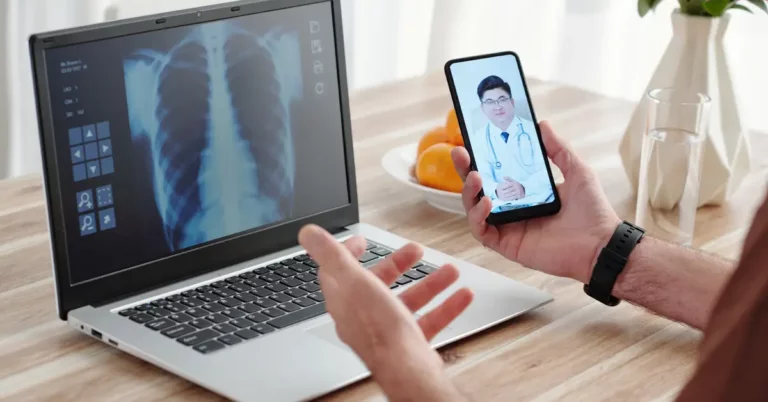Remote Patient Monitoring (RPM) is a digital health tool that allows for the remote monitoring of patients’ health conditions. It is an essential tool for patients with asthma, as it helps to manage their condition better and improve their outcomes. The critical elements of RPM include biometric monitoring, digital technology, and remote communication between patients and healthcare providers.
RPM has emerged as a promising solution for patients with asthma, offering a convenient and effective way to monitor their condition and manage their care. RPM combines telehealth and digital technology to provide patients with real-time monitoring of their symptoms and biometric data and to provide doctors with the information they need to make informed decisions about treatment.
This article will explore the benefits of incorporating RPM into the care of asthmatic patients, from improved asthma control and management to better adherence to treatment plans and improved quality of care. This will also discuss the role of RPM and its potential to enhance the delivery of care for asthma patients.
What is Asthma?
Asthma is a chronic respiratory condition affecting the airways, making breathing difficult. It is characterized by shortness of breath, chest tightness, wheezing, and difficulty breathing. Asthma is caused by a combination of genetic and environmental factors and can be triggered by various allergens or irritants, such as dust, pollen, pet dander, or air pollution.
Asthma is a lifelong condition that cannot be cured, but it can be managed with proper treatment and care. Asthma treatment typically includes medications, such as inhaled corticosteroids, bronchodilators, and rescue inhalers, as well as lifestyle changes, such as avoiding triggers and maintaining good overall health.
Asthma can range from mild to severe, and its severity can change over time. Asthma patients need to work with their healthcare provider to develop a personalized treatment plan like the RPM program to monitor their symptoms and condition regularly to ensure that their asthma is well-controlled.
The Benefits of Incorporating Remote Monitoring for Asthma Care Management
- Improved patient management plans
- Better monitoring of asthma symptoms such as chest tightness, wheezing, and chronic coughing
- Ability to transmit symptom information automatically to healthcare providers
- More effective asthma management and ability to respond quickly to changes in symptoms
- Elimination of the need for in-person visits, making care more convenient for patients
- Improvement in medication adherence through electronic medication dispensers
- Reduction of the risk of exposure during the COVID-19 pandemic
- Positive impact on asthma outcomes and overall quality of care received by patients
- Convenient healthcare and improved adherence to treatment plans
- Better monitoring of patients’ asthma symptoms leads to better asthma outcomes.
How Remote Patient Monitoring Can Help Patients with Asthma
- Monitoring Asthma Symptoms from Home: With remote monitoring technology, patients can monitor their asthma symptoms, such as chest tightness, wheezing, and chronic coughing, from the comfort of their homes, eliminating the need for frequent in-person visits to the doctor’s office or clinic.
- Incorporating Biometric Monitoring Devices: Patients can use digital health tools such as pulse oximeters and mouthpieces integrated with electronics to measure biometric data and transmit it automatically to the doctor via a mobile device or smartphone.
- Medication Monitoring and Adherence: Remote monitoring can help track patients’ medication adherence and automatically transmit data to doctors via electronic medication management systems. This can improve adherence to medications such as corticosteroids and help prevent asthma attacks or uncontrolled asthma exacerbations.
- Symptom Surveys and Data Collection: Remote monitoring technology can also be used to collect symptom data from patients through symptom surveys, which can help providers better understand the range of symptoms from mild to severe. This data can be used to personalize care plans and track the effectiveness of treatment over time.
The Impact of Remote Monitoring on Asthma Outcomes
- Meta-analysis of Randomized Controlled Trials: A meta-analysis of randomized controlled trials has shown that remote monitoring can significantly improve asthma outcomes, such as reduced frequency of exacerbations, better symptom control, and improved quality of life for patients.
- Enhanced Quality of Care: Remote monitoring can make care more convenient for patients, as it eliminates the need for frequent in-person visits to the doctor’s office or clinic. This can lead to improved quality of care, as patients can receive more prompt and effective treatment for their asthma symptoms.
- Improved Self-Management and Adherence: By allowing patients to monitor their symptoms and medication use from home, remote monitoring can help improve self-management and adherence to treatment plans. This can result in better control of symptoms and reduced frequency of exacerbations.
- Value-based Care: Remote monitoring can also be used to support value-based care delivery, as it allows doctors to collect real-time data on patient’s symptoms and medication use. This data can be used to personalize care plans and track the effectiveness of treatment over time, leading to improved outcomes and reduced costs for the health system.
Implementing Remote Monitoring in the Health System Managing Patients with Asthma
Integration of Monitoring and Telehealth
Remote monitoring can be integrated with telehealth services to provide patients a seamless and convenient experience. This can involve connecting patients with care providers via video or audio calls, allowing for real-time monitoring and assessment of symptoms.
Cooperation between Pulmonologists and Primary Care Providers
Implementing remote monitoring in the health system requires cooperation between pulmonologists and primary care providers. This can involve sharing data and coordinating care plans to provide a comprehensive and integrated approach to asthma management.
Improved Care Delivery via Digital Technology
Remote monitoring technology can help improve care delivery by providing real-time data on patient’s symptoms and medication use. This data can be used to personalize care plans and track the effectiveness of treatment over time. Digital technology can also be used to support self-management and patient education, helping patients to understand better their asthma and how to manage it effectively.
Integration with Electronic Health Records (EHRs)
Remote monitoring data can be integrated with electronic health records (EHRs) to provide a comprehensive view of patient’s health and allow for better care coordination across the health system. This can help providers make more informed decisions and provide more effective treatment for patients.
Adoption by Many Providers
The success of remote monitoring in the health system depends on widespread adoption by many providers. This can involve training and education for providers on how to use the technology effectively and integrate it into their care delivery processes.
Adherence to Treatment Plans and Improved Quality of Care with DrKumo RPM Solutions
RPM provides real-time monitoring of patients’ biometric information, symptoms, and medication use, allowing healthcare providers to track the condition’s progression and make necessary adjustments to treatment plans. RPM has been shown to improve asthma control, increase adherence to treatment plans, and improve the quality of care for patients with asthma.
Remote patient monitoring is an innovative solution that can help patients with asthma to manage their condition better and receive the care they need. The future of asthma care is moving towards a more digital and connected approach, and RPM will play a critical role in this transformation.
DrKumo RPM, a user-friendly solution powered by our state-of-the-art, HIPAA-compliant, mobile-enabled, continuous real-time monitoring, and AI/ML engine technology, enables patients to manage their health conditions in the comfort of their homes and supports healthcare providers with real-time intelligence for timely intervention. DrKumo RPM enables healthcare providers to monitor patients’ asthma symptoms and biometric information in real-time, allowing them to make adjustments to treatment plans as needed. This helps to improve asthma control and reduce the risk of exacerbations. The real-time data collection and analysis provided by RPM also help healthcare providers identify patient symptoms patterns and tailor treatment plans to their specific needs.
Takeaway
RPM for asthma patients can be highly beneficial by providing real-time data on symptoms and medication use, which can be monitored from home. When combined with telehealth and electronic health records (EHRs), this approach offers a comprehensive approach to managing asthma, improving the quality of care, and reducing costs. The adoption of remote monitoring by healthcare providers is critical to its success. Evidence from meta-analyses of trials and studies has shown that remote monitoring improves asthma outcomes, including reduced exacerbations, better symptom control, and improved quality of life for patients. With the rise of digital health technologies and value-based care delivery, remote monitoring can revolutionize asthma management by making it more convenient, effective, and affordable for patients.
Consider the potential benefits of remote patient monitoring for asthma management in your practice. Contact us now!








